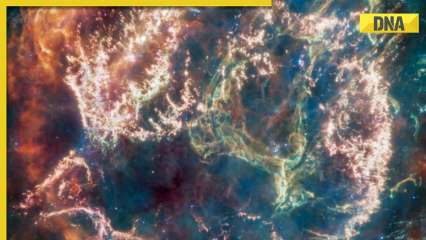Astronomers find enigmatic remnants of star that went supernova 340 years ago
NASA’s James Webb Telescope captured the astonishing image of an exploding supernova on Friday, providing scientists with new insights. The clear picture of Cassiopeia sheds new light on the constellation. NASA has announced the discovery of the youngest known relic of a supernova explosion, which occurred 340 years ago.
This picture was captured by the telescope’s Mid-Infrared Instrument, which much improves upon earlier infrared photography. The picture is then converted into the spectrum of light we can see.
On Christmas Day, 2021, the $10 billion telescope was launched. Since then, it has been sending back photographs, providing unprecedented vistas of our galaxy and beyond to scientists.
This supernova remnant has been studied in detail for the first time thanks to the findings announced on Friday. NASA’s Chandra X-ray observatory, which was deployed into orbit in 1999, is only one of several space and ground-based observatories that have investigated Cassiopeia A in great detail.
This nebula has a circular shape and a complicated structure. Curtains of material, burning orange like fire, may be seen on the outside of the circle, especially on the left side of the picture. A brilliant pink ring of variegated filaments, studded with clumps and knots, may be found within this outer shell.
From the ring’s top right, an emerald arc winds its way into the hollow heart at its centre. All around the picture are gauzy streaks of colour, blue, green, and red.
Where debris from the exploding star is smashing into the surrounding gas and dust is shown by the orange layers at the image’s periphery. Elements like oxygen, argon, and neon, which originated in the star, are contained inside that outer shell.
Also, READ: Mysterious red asteroids discovered near Neptune, may reveal secrets about Solar System
Stars: always making a dramatic exit!
Webb’s powerful infrared eye has captured never-before-seen detail of Cassiopeia A (Cas A). 11,000 light-years away, it is the remnant of a massive star that exploded about 340 years ago: https://t.co/LLQsFQJwVQ pic.twitter.com/xqlGFzhYoy
— NASA Webb Telescope (@NASAWebb) April 7, 2023
Cas A provides unique insight into the demise of a star since it is the youngest known relic of an exploded, big star in our galaxy. Webb researchers want to learn more about the creation and distribution of cosmic dust, the building blocks of the components that make up our bodies, by analysing Cas A.

NASA’s James Webb Telescope captured the astonishing image of an exploding supernova on Friday, providing scientists with new insights. The clear picture of Cassiopeia sheds new light on the constellation. NASA has announced the discovery of the youngest known relic of a supernova explosion, which occurred 340 years ago.
This picture was captured by the telescope’s Mid-Infrared Instrument, which much improves upon earlier infrared photography. The picture is then converted into the spectrum of light we can see.
On Christmas Day, 2021, the $10 billion telescope was launched. Since then, it has been sending back photographs, providing unprecedented vistas of our galaxy and beyond to scientists.
This supernova remnant has been studied in detail for the first time thanks to the findings announced on Friday. NASA’s Chandra X-ray observatory, which was deployed into orbit in 1999, is only one of several space and ground-based observatories that have investigated Cassiopeia A in great detail.
This nebula has a circular shape and a complicated structure. Curtains of material, burning orange like fire, may be seen on the outside of the circle, especially on the left side of the picture. A brilliant pink ring of variegated filaments, studded with clumps and knots, may be found within this outer shell.
From the ring’s top right, an emerald arc winds its way into the hollow heart at its centre. All around the picture are gauzy streaks of colour, blue, green, and red.
Where debris from the exploding star is smashing into the surrounding gas and dust is shown by the orange layers at the image’s periphery. Elements like oxygen, argon, and neon, which originated in the star, are contained inside that outer shell.
Also, READ: Mysterious red asteroids discovered near Neptune, may reveal secrets about Solar System
Stars: always making a dramatic exit!
Webb’s powerful infrared eye has captured never-before-seen detail of Cassiopeia A (Cas A). 11,000 light-years away, it is the remnant of a massive star that exploded about 340 years ago: https://t.co/LLQsFQJwVQ pic.twitter.com/xqlGFzhYoy
— NASA Webb Telescope (@NASAWebb) April 7, 2023
Cas A provides unique insight into the demise of a star since it is the youngest known relic of an exploded, big star in our galaxy. Webb researchers want to learn more about the creation and distribution of cosmic dust, the building blocks of the components that make up our bodies, by analysing Cas A.
